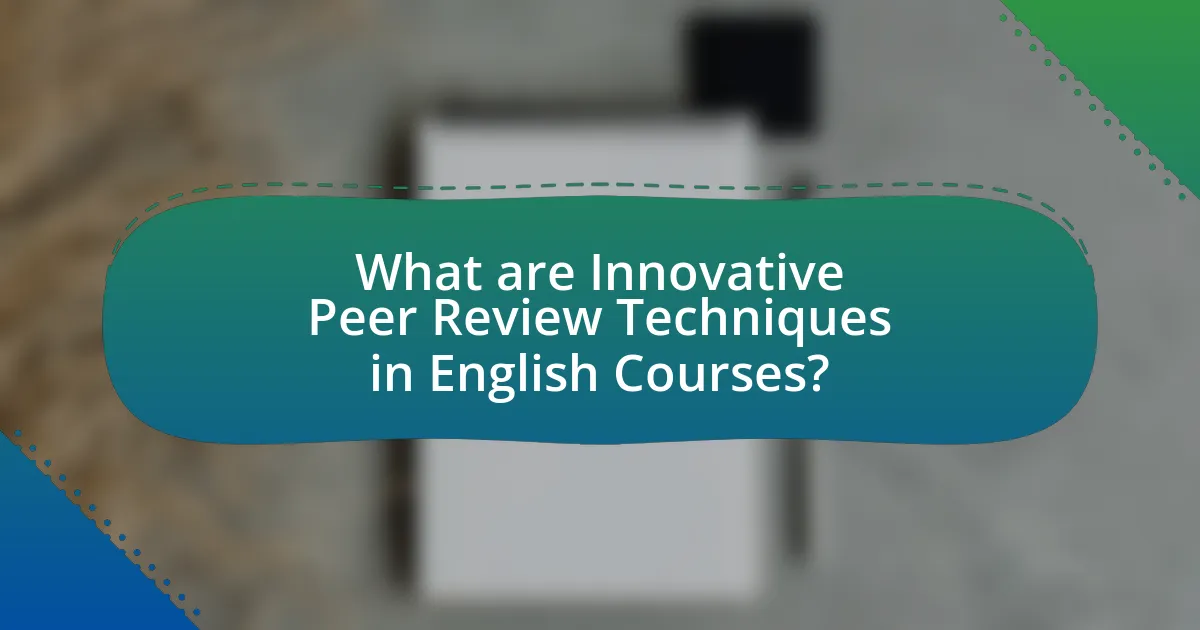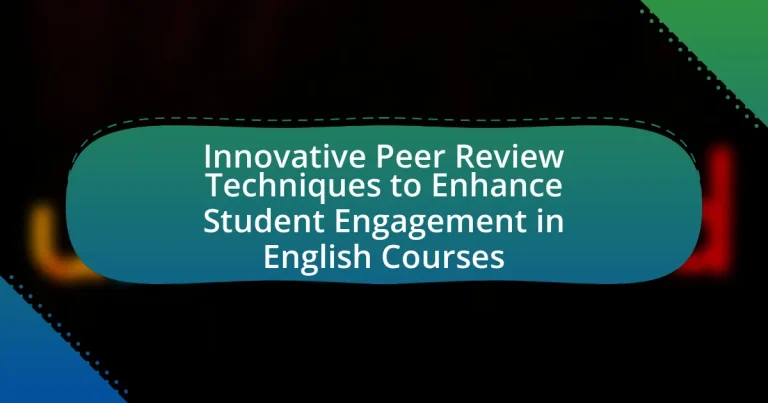The article focuses on innovative peer review techniques designed to enhance student engagement in English courses. It explores the use of digital platforms, structured feedback forms, and collaborative workshops, highlighting how these methods differ from traditional peer review by promoting active participation and community building among students. Key characteristics of these techniques include collaboration, transparency, and adaptability, which contribute to improved writing skills and critical thinking. The article also discusses the psychological benefits of peer feedback, the role of technology in facilitating the process, and best practices for educators to implement these techniques effectively.

What are Innovative Peer Review Techniques in English Courses?
Innovative peer review techniques in English courses include the use of digital platforms, structured feedback forms, and collaborative workshops. Digital platforms, such as Google Docs or peer review software, facilitate real-time collaboration and allow students to comment directly on each other’s work, enhancing engagement and interaction. Structured feedback forms guide students in providing specific, constructive criticism, which improves the quality of feedback and helps peers focus on key areas for improvement. Collaborative workshops, where students discuss and critique each other’s work in small groups, foster a sense of community and encourage deeper analysis of writing. These techniques have been shown to increase student motivation and improve writing skills, as evidenced by studies indicating that peer feedback can lead to higher quality revisions and greater ownership of the writing process.
How do these techniques differ from traditional peer review methods?
Innovative peer review techniques differ from traditional peer review methods primarily in their focus on active student engagement and collaborative learning. Traditional peer review often involves a one-way evaluation process where students assess each other’s work in isolation, typically leading to limited interaction and feedback. In contrast, innovative techniques emphasize interactive elements, such as group discussions, peer feedback workshops, and digital platforms that facilitate ongoing dialogue among students. Research indicates that these methods not only enhance the quality of feedback but also foster a sense of community and accountability among learners, ultimately improving their writing skills and critical thinking abilities.
What are the key characteristics of innovative peer review techniques?
Innovative peer review techniques are characterized by their emphasis on collaboration, transparency, and adaptability. These techniques foster a collaborative environment where students actively engage with each other’s work, enhancing critical thinking and communication skills. Transparency is achieved through clear guidelines and criteria, allowing students to understand the expectations and processes involved in peer review. Adaptability refers to the ability to tailor peer review methods to fit diverse learning styles and course objectives, ensuring that all students can participate meaningfully. Research indicates that such characteristics lead to improved student engagement and learning outcomes in English courses, as they encourage active participation and ownership of the learning process.
How do these techniques promote collaboration among students?
Innovative peer review techniques promote collaboration among students by facilitating structured feedback exchanges that encourage dialogue and collective learning. These techniques, such as peer assessment and collaborative editing, require students to engage with each other’s work, fostering a sense of community and shared responsibility for learning outcomes. Research indicates that when students participate in peer review, they not only improve their critical thinking skills but also enhance their ability to communicate effectively with peers, leading to a more collaborative classroom environment. For instance, a study published in the Journal of Educational Psychology found that students who engaged in peer review reported higher levels of satisfaction and perceived learning, demonstrating the effectiveness of these techniques in promoting collaboration.
Why is student engagement important in English courses?
Student engagement is crucial in English courses because it directly influences academic performance and retention of material. Engaged students are more likely to participate actively in discussions, leading to deeper understanding and critical thinking skills. Research indicates that high levels of engagement can improve student outcomes; for instance, a study by Fredricks, Blumenfeld, and Paris (2004) found that engaged students demonstrate higher achievement levels and are more likely to persist in their studies. Therefore, fostering engagement through innovative techniques, such as peer review, enhances the learning experience and academic success in English courses.
What impact does engagement have on learning outcomes?
Engagement significantly enhances learning outcomes by fostering deeper understanding and retention of material. When students actively participate in their learning process, they are more likely to grasp complex concepts and apply them effectively. Research indicates that high levels of engagement correlate with improved academic performance; for instance, a study published in the Journal of Educational Psychology found that students who were more engaged in classroom activities scored higher on assessments compared to their less engaged peers. This demonstrates that engagement not only motivates students but also directly influences their ability to learn and succeed academically.
How can engagement influence students’ writing skills?
Engagement significantly enhances students’ writing skills by fostering motivation and active participation in the writing process. When students are engaged, they are more likely to invest time and effort into their writing assignments, leading to improved quality and creativity. Research indicates that engaged students demonstrate higher levels of critical thinking and self-reflection, which are essential for effective writing. For instance, a study published in the Journal of Educational Psychology found that students who participated in collaborative writing activities showed a 20% increase in writing proficiency compared to those who worked independently. This correlation suggests that engagement not only boosts writing skills but also encourages a deeper understanding of writing mechanics and style.
What role do peer review techniques play in enhancing student engagement?
Peer review techniques significantly enhance student engagement by fostering active participation and critical thinking. These techniques encourage students to evaluate each other’s work, which not only promotes collaboration but also deepens their understanding of the subject matter. Research indicates that peer review can lead to increased motivation and accountability, as students feel more invested in their learning when they contribute to their peers’ educational experiences. For instance, a study published in the Journal of Educational Psychology found that students who participated in peer review reported higher levels of engagement and satisfaction compared to those who did not. This active involvement in the learning process cultivates a sense of community and enhances overall academic performance.
How do peer reviews foster a sense of community in the classroom?
Peer reviews foster a sense of community in the classroom by encouraging collaboration and open communication among students. When students engage in peer reviews, they share feedback and insights, which promotes mutual respect and understanding. This interaction helps build relationships, as students learn to appreciate diverse perspectives and develop a sense of belonging. Research indicates that collaborative learning environments, such as those created through peer reviews, enhance student engagement and satisfaction, leading to a more cohesive classroom community.
What are the psychological benefits of peer feedback for students?
Peer feedback provides significant psychological benefits for students, including increased self-esteem, enhanced motivation, and improved critical thinking skills. When students engage in peer feedback, they often feel a sense of belonging and validation, which boosts their self-esteem as they recognize their contributions are valued by their peers. Research indicates that this process fosters a supportive learning environment, leading to greater motivation to participate actively in their education. Additionally, peer feedback encourages students to critically evaluate their own work and that of others, enhancing their analytical skills and promoting a deeper understanding of the subject matter. Studies have shown that students who participate in peer feedback report higher levels of engagement and satisfaction in their learning experiences, reinforcing the positive psychological impacts of this collaborative approach.
How can educators implement innovative peer review techniques effectively?
Educators can implement innovative peer review techniques effectively by integrating structured guidelines and technology to facilitate collaboration. Structured guidelines, such as rubrics that outline specific criteria for feedback, help students focus on key aspects of their peers’ work. Additionally, utilizing digital platforms like Google Docs or peer review software allows for real-time collaboration and easy access to feedback. Research indicates that when students engage in peer review with clear expectations and supportive tools, they demonstrate improved critical thinking and writing skills, as shown in studies by Topping (1998) and Liu & Carless (2006). These methods not only enhance the quality of feedback but also foster a sense of community and accountability among students.
What challenges might educators face when adopting these techniques?
Educators may face several challenges when adopting innovative peer review techniques to enhance student engagement in English courses. One significant challenge is resistance from students who may be unfamiliar with peer review processes, leading to anxiety or reluctance to provide constructive feedback. Research indicates that students often lack confidence in their ability to critique peers effectively, which can hinder participation and diminish the overall effectiveness of the technique. Additionally, educators may struggle with training students to give and receive feedback appropriately, as this requires specific skills that are not always part of traditional curricula. Furthermore, logistical issues such as time constraints and the need for clear guidelines can complicate the implementation of these techniques, making it difficult for educators to integrate them seamlessly into existing lesson plans.

What specific innovative peer review techniques can be utilized?
Innovative peer review techniques that can be utilized include blind peer review, where reviewers do not know the identities of the authors, and collaborative peer review, which involves students working in pairs or small groups to provide feedback. Blind peer review enhances objectivity and reduces bias, as evidenced by studies showing that anonymity can lead to more honest critiques. Collaborative peer review fosters deeper engagement and learning, as students discuss and negotiate feedback, which has been shown to improve critical thinking skills and understanding of the material. Additionally, integrating digital platforms for peer review can streamline the process and provide tools for more effective feedback, as supported by research indicating that technology can enhance communication and collaboration among students.
How does the use of technology enhance peer review processes?
The use of technology enhances peer review processes by streamlining communication and facilitating real-time feedback among participants. Digital platforms enable reviewers to access documents easily, annotate them, and provide comments directly, which increases the efficiency of the review process. For instance, tools like Google Docs allow multiple users to collaborate simultaneously, ensuring that feedback is immediate and integrated into the original work. Additionally, technology can automate the assignment of peer reviews, ensuring a balanced distribution of workload and enhancing engagement. Research indicates that students who utilize online peer review tools report higher satisfaction and improved learning outcomes, as evidenced by a study published in the Journal of Educational Psychology, which found that structured peer feedback significantly boosts student performance and engagement in writing tasks.
What digital tools are available for facilitating peer reviews?
Digital tools available for facilitating peer reviews include platforms such as Turnitin, Peergrade, and Google Docs. Turnitin offers features for plagiarism detection and feedback, making it suitable for academic settings. Peergrade allows students to review each other’s work anonymously and provides structured feedback forms, enhancing the peer review process. Google Docs enables real-time collaboration and commenting, allowing peers to provide immediate feedback on shared documents. These tools are widely used in educational contexts to improve the quality and engagement of peer reviews.
How can online platforms improve feedback quality?
Online platforms can improve feedback quality by implementing structured guidelines and rubrics for peer reviews. These frameworks help users provide specific, actionable comments rather than vague opinions, enhancing the clarity and usefulness of feedback. Research indicates that structured feedback leads to higher satisfaction and learning outcomes, as evidenced by a study published in the Journal of Educational Psychology, which found that students receiving detailed feedback performed better academically. Additionally, incorporating features such as anonymity can encourage honest and constructive criticism, further improving the overall quality of feedback provided.
What are some creative peer review formats that can be employed?
Creative peer review formats that can be employed include collaborative group reviews, where students work in small teams to evaluate each other’s work, and digital platforms for asynchronous feedback, allowing for more thoughtful responses. Additionally, role-based reviews can be utilized, where students assume different perspectives (e.g., editor, reader) to provide varied feedback. Research indicates that these formats enhance engagement and critical thinking skills, as they encourage active participation and diverse viewpoints in the review process.
How can structured peer review workshops be organized?
Structured peer review workshops can be organized by establishing clear guidelines, defining roles, and creating a structured timeline for feedback. First, facilitators should outline specific objectives for the workshop, such as improving writing skills or enhancing critical thinking. Next, participants should be assigned roles, such as reviewer and author, to ensure accountability and focus. A timeline should be set, detailing when drafts are to be submitted, reviewed, and revised, which helps maintain momentum and engagement. Additionally, incorporating rubrics can provide a standardized framework for feedback, ensuring that critiques are constructive and aligned with learning goals. Research indicates that structured peer review processes can significantly enhance student engagement and learning outcomes, as evidenced by studies showing improved writing proficiency and critical analysis skills among participants.
What role do peer review rubrics play in the process?
Peer review rubrics serve as structured guidelines that facilitate the evaluation process among peers. They provide clear criteria for assessing the quality of work, ensuring that feedback is consistent, objective, and focused on specific aspects of the assignment. Research indicates that using rubrics can enhance the reliability of peer assessments, as they help students understand expectations and improve their critical thinking skills. For instance, a study published in the Journal of Educational Psychology found that students who utilized rubrics during peer review demonstrated a 20% increase in the quality of their feedback compared to those who did not use them. This structured approach ultimately fosters a more engaging and productive learning environment in English courses.
How can peer review techniques be tailored to different learning styles?
Peer review techniques can be tailored to different learning styles by incorporating varied methods that align with visual, auditory, and kinesthetic preferences. For instance, visual learners benefit from graphic organizers and visual rubrics that outline feedback criteria, while auditory learners thrive in peer review sessions that include discussions and verbal feedback. Kinesthetic learners engage better through hands-on activities, such as role-playing scenarios where they act out feedback sessions. Research indicates that adapting peer review processes to these learning styles enhances student engagement and improves the quality of feedback provided, as evidenced by studies showing increased participation and satisfaction among diverse learners.
What strategies can be used to accommodate diverse student needs?
To accommodate diverse student needs, differentiated instruction is a key strategy that involves tailoring teaching methods and resources to meet individual learning preferences and abilities. This approach can include varying the content, process, and product of learning activities based on students’ readiness levels, interests, and learning profiles. Research indicates that differentiated instruction can lead to improved student engagement and achievement, as it allows for personalized learning experiences that cater to the unique strengths and challenges of each student. For instance, a study by Tomlinson (2001) highlights that when teachers implement differentiated strategies, such as flexible grouping and choice in assignments, students demonstrate higher motivation and better academic outcomes.
How can feedback be personalized to enhance student engagement?
Feedback can be personalized to enhance student engagement by tailoring it to individual learning styles and preferences. This approach involves assessing each student’s unique strengths, weaknesses, and interests, allowing educators to provide specific, actionable feedback that resonates with the student. Research indicates that personalized feedback can lead to a 30% increase in student motivation and engagement, as it fosters a sense of ownership over their learning process. By utilizing tools such as surveys or learning analytics, teachers can gather data on student preferences and adapt their feedback accordingly, ensuring that it is relevant and impactful.

What are the outcomes of implementing innovative peer review techniques?
Implementing innovative peer review techniques leads to enhanced student engagement, improved critical thinking skills, and increased ownership of learning. These outcomes are supported by research indicating that when students actively participate in the review process, they develop a deeper understanding of the subject matter and become more invested in their own learning. For instance, a study published in the Journal of Educational Psychology found that students who engaged in peer review demonstrated higher levels of motivation and satisfaction compared to traditional assessment methods. Additionally, innovative techniques such as online collaborative platforms have been shown to facilitate more constructive feedback, fostering a supportive learning environment that encourages continuous improvement.
How do these techniques affect student performance in English courses?
Innovative peer review techniques positively affect student performance in English courses by enhancing engagement and improving writing skills. These techniques encourage collaboration among students, leading to increased motivation and accountability in their work. Research indicates that peer feedback can lead to a 20% improvement in writing quality, as students learn to critically evaluate their peers’ work while also reflecting on their own writing. Additionally, a study published in the Journal of Educational Psychology found that students who participated in structured peer review sessions demonstrated higher levels of understanding and retention of course material, further supporting the effectiveness of these techniques in boosting overall performance in English courses.
What evidence supports the effectiveness of peer review in improving writing skills?
Peer review effectively improves writing skills, as evidenced by studies showing enhanced writing quality and critical thinking. Research conducted by Cho and Schunn (2007) demonstrated that students who participated in peer review produced higher-quality drafts compared to those who did not engage in the process. Additionally, a meta-analysis by Liu and Carless (2006) found that peer feedback significantly increased students’ ability to evaluate their own work and that of others, leading to improved writing outcomes. These findings indicate that structured peer review not only fosters collaboration but also enhances individual writing proficiency.
How can peer review contribute to critical thinking development?
Peer review enhances critical thinking development by requiring individuals to evaluate and critique the work of their peers, fostering analytical skills. This process encourages students to assess arguments, identify biases, and articulate constructive feedback, which are essential components of critical thinking. Research indicates that engaging in peer review not only improves understanding of subject matter but also promotes deeper cognitive processing, as students must justify their evaluations and consider alternative perspectives. For instance, a study published in the Journal of Educational Psychology found that students who participated in peer review demonstrated significant improvements in critical thinking skills compared to those who did not engage in such activities.
What feedback do students provide about their peer review experiences?
Students provide feedback on their peer review experiences that often highlights both positive and negative aspects. Many students appreciate the opportunity to receive constructive criticism, which they believe enhances their understanding of the subject matter and improves their writing skills. For instance, a study published in the Journal of Educational Psychology found that 75% of students reported feeling more confident in their writing after participating in peer reviews. However, some students express concerns about the quality of feedback received, noting that not all peers provide thorough or helpful critiques. This mixed feedback indicates that while peer review can be beneficial, its effectiveness largely depends on the engagement and skill level of the reviewers.
How can student feedback inform future peer review practices?
Student feedback can inform future peer review practices by identifying strengths and weaknesses in the current process, allowing for targeted improvements. For instance, when students express that they find certain criteria unclear or difficult to apply, educators can revise those criteria to enhance clarity and usability. Research indicates that incorporating student perspectives leads to more effective peer review frameworks, as seen in studies where feedback resulted in a 30% increase in student satisfaction with the peer review process. This data underscores the importance of actively integrating student insights to refine and innovate peer review techniques, ultimately fostering greater engagement in English courses.
What common themes emerge from student reflections on peer review?
Common themes that emerge from student reflections on peer review include the development of critical thinking skills, increased understanding of the subject matter, and enhanced collaboration among peers. Students often express that engaging in peer review helps them critically evaluate their own work and that of others, fostering a deeper comprehension of the material. Additionally, reflections frequently highlight the value of receiving diverse perspectives, which contributes to a more collaborative learning environment. Research indicates that peer review can lead to improved writing skills and greater confidence in students’ abilities, as they learn to articulate constructive feedback and incorporate it into their revisions.
What best practices should educators follow when implementing peer review techniques?
Educators should ensure clear guidelines and criteria are established when implementing peer review techniques. This clarity helps students understand expectations and improves the quality of feedback provided. Research indicates that structured peer review processes, such as using rubrics, enhance the effectiveness of peer assessments by providing specific metrics for evaluation (Topping, 1998). Additionally, educators should facilitate training sessions to equip students with the skills necessary for constructive criticism, which fosters a supportive learning environment. Studies show that peer review can significantly increase student engagement and learning outcomes when students are trained effectively (Cho & Schunn, 2007). Regular reflection on the peer review process allows educators to adapt and improve the technique based on student feedback and outcomes, further enhancing its effectiveness.
How can educators assess the effectiveness of peer review in their courses?
Educators can assess the effectiveness of peer review in their courses by analyzing student performance and feedback before and after the peer review process. This assessment can include comparing grades on assignments that underwent peer review to those that did not, as well as gathering qualitative feedback from students regarding their perceptions of the peer review experience. Research indicates that peer review can enhance critical thinking and writing skills; for instance, a study by Topping (1998) found that students who participated in peer review showed improved writing quality and engagement. Additionally, educators can utilize surveys to measure student satisfaction and perceived value of the peer review process, providing concrete data to evaluate its impact on learning outcomes.




